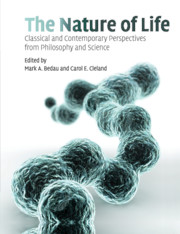Book contents
- Frontmatter
- Contents
- Preface
- Acknowledgments
- Sources
- About the authors
- Introduction
- SECTION I CLASSICAL DISCUSSIONS OF LIFE
- SECTION II THE ORIGIN AND EXTENT OF NATURAL LIFE
- SECTION III ARTIFICIAL LIFE AND SYNTHETIC BIOLOGY
- 16 Learning from functionalism: prospects for strong artificial life
- 17 Life, “artificial life,” and scientific explanation
- 18 Alien life: how would we know?
- 19 Automatic design and manufacture of robotic life forms
- 20 A giant step towards artificial life?
- 21 Approaches to semi-synthetic minimal cells: a review
- 22 Creating “real life”
- SECTION IV DEFINING AND EXPLAINING LIFE
- Supplementary bibliography on life
- Index
- References
19 - Automatic design and manufacture of robotic life forms
Published online by Cambridge University Press: 10 November 2010
- Frontmatter
- Contents
- Preface
- Acknowledgments
- Sources
- About the authors
- Introduction
- SECTION I CLASSICAL DISCUSSIONS OF LIFE
- SECTION II THE ORIGIN AND EXTENT OF NATURAL LIFE
- SECTION III ARTIFICIAL LIFE AND SYNTHETIC BIOLOGY
- 16 Learning from functionalism: prospects for strong artificial life
- 17 Life, “artificial life,” and scientific explanation
- 18 Alien life: how would we know?
- 19 Automatic design and manufacture of robotic life forms
- 20 A giant step towards artificial life?
- 21 Approaches to semi-synthetic minimal cells: a review
- 22 Creating “real life”
- SECTION IV DEFINING AND EXPLAINING LIFE
- Supplementary bibliography on life
- Index
- References
Summary
In the field of artificial life, “life as it could be” is examined on the basis of understanding the principles, and simulating the mechanisms, of real biological forms. Just as aeroplanes use the same principles as birds, but have fixed wings, artificial lifeforms may share the same principles, but not the same implementation in chemistry. Stored energy, autonomous movement, and even animal communication are replicated in toys using batteries, motors, and computer chips.
Our central claim is that to realize artificial life, full autonomy must be attained not only at the level of power and behavior (the goal of robotics, today), but also at the levels of design and fabrication. Only then can we expect synthetic creatures to sustain their own evolution. We thus seek automatically designed and constructed physical artifacts that are functional in the real world, diverse in architecture (possibly each slightly different), and automatically producible with short turnaround time, at low cost and in large quantities. So far these requirements have not been met.
The experiments described here use evolutionary computation for design, and additive fabrication for reproduction. The evolutionary process operates on a population of candidate robots, each composed of some repertoire of building blocks. The evolutionary process iteratively selects fitter machines, creates offspring by adding, modifying and removing building blocks using a set of operators, and replaces them into the population (see Methods section). Evolutionary computation has been applied to many engineering problems.
- Type
- Chapter
- Information
- The Nature of LifeClassical and Contemporary Perspectives from Philosophy and Science, pp. 260 - 267Publisher: Cambridge University PressPrint publication year: 2010



